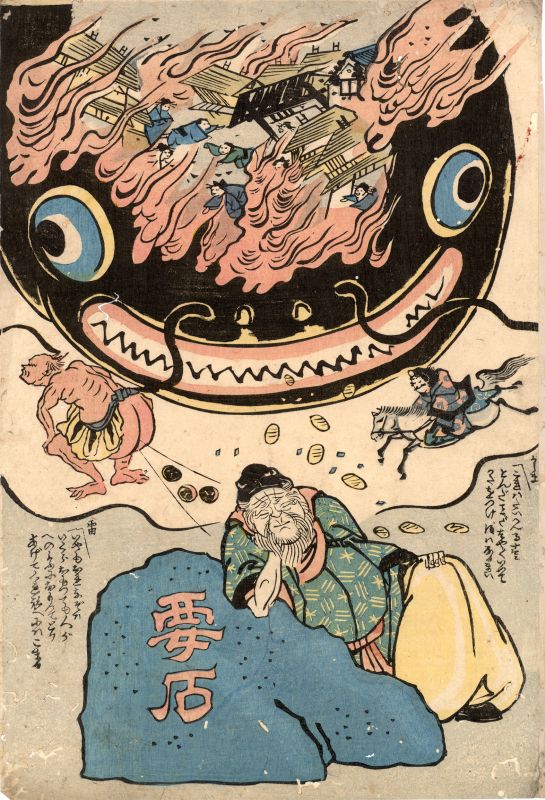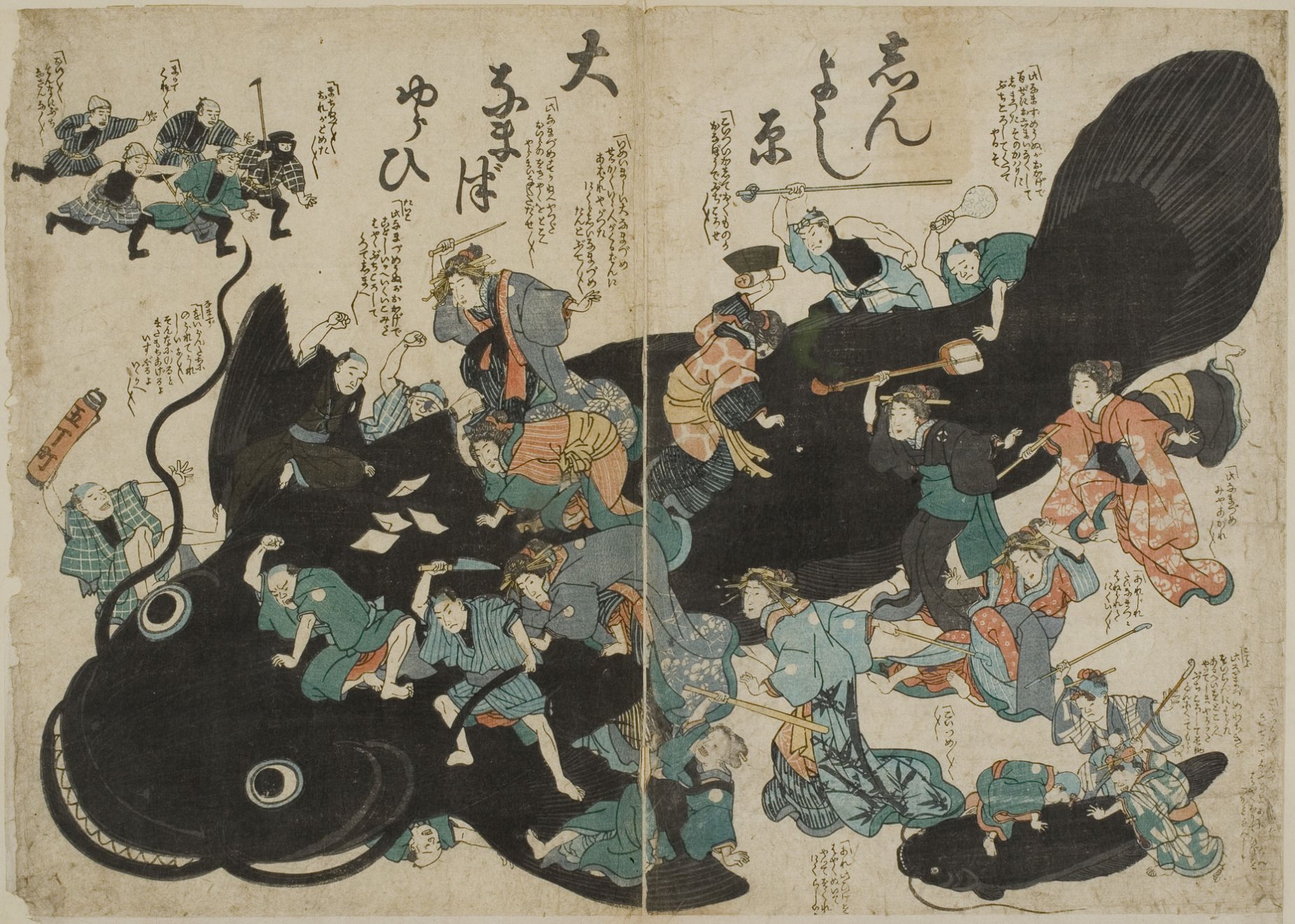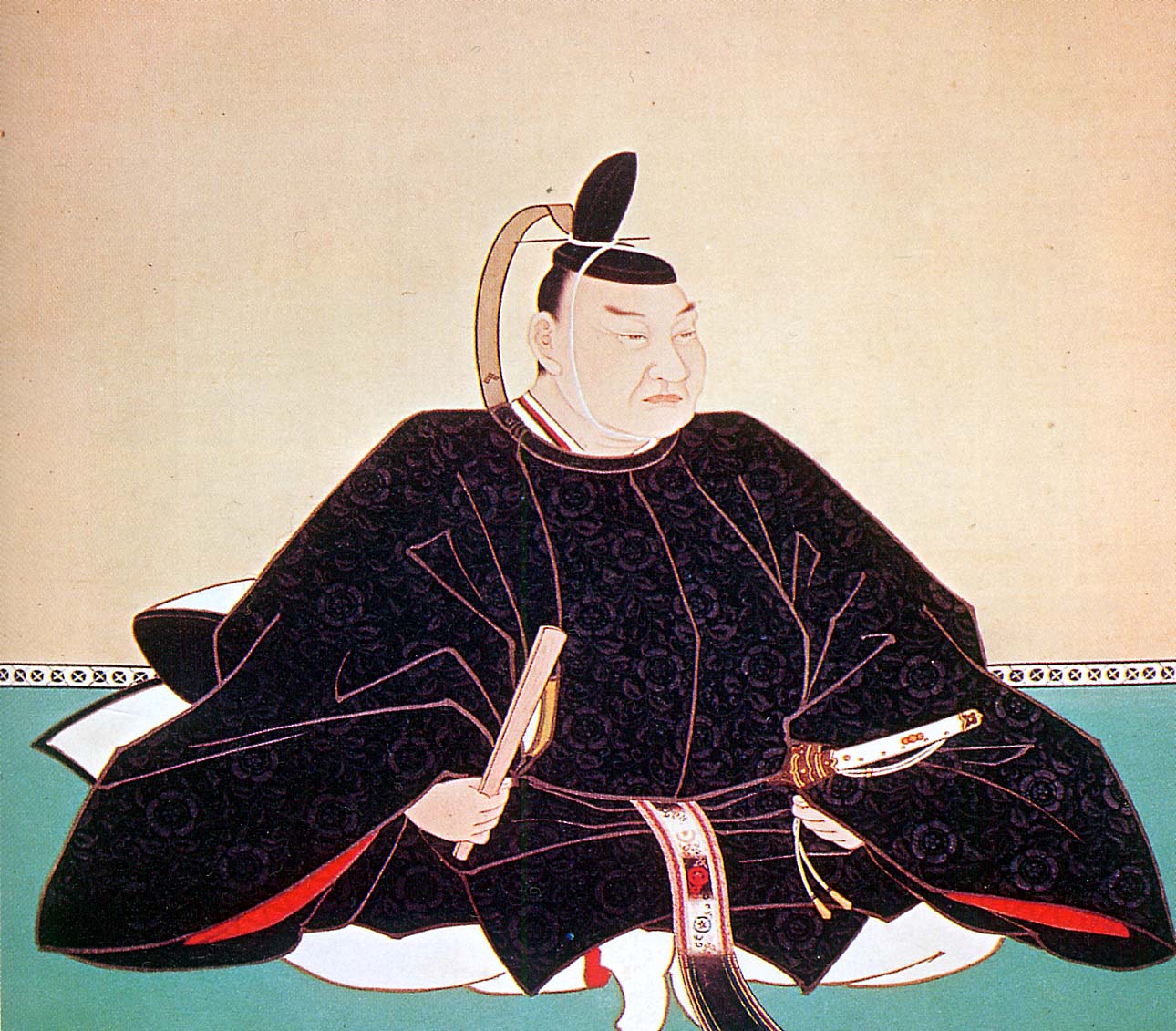|
1855 Ansei Edo Earthquake
The , was the third Ansei Great Earthquake, which occurred during the late-Edo period. It occurred after the 1854 Nankai earthquake, which took place about a year prior. The earthquake occurred at 22:00 local time on 11 November. It had an epicenter close to Edo (now Tokyo), causing considerable damage in the Kantō region from the shaking and subsequent fires, with a death toll of 7,000–10,000 people and destroyed around 14,000 buildings. The earthquake had a magnitude of 7.0 on the surface wave magnitude scale and reached a maximum intensity of XI (''Extreme'') on the Mercalli intensity scale. The earthquake triggered a minor tsunami. Tectonic setting The Kanto area lies above a complex part of the convergent boundaries between the subducting Pacific and Philippine Sea Plates and the overriding Eurasian and North American Plates. Earthquakes with epicenters in the Kantō region may occur within the Eurasian Plate, at the Eurasian Plate/Philippine Sea Plate interface, with ... [...More Info...] [...Related Items...] OR: [Wikipedia] [Google] [Baidu] |
Surface Wave Magnitude
The surface wave magnitude (M_s) scale is one of the magnitude scales used in seismology to describe the size of an earthquake. It is based on measurements of Rayleigh surface waves that travel along the uppermost layers of the Earth. This magnitude scale is related to the local magnitude scale proposed by Charles Francis Richter in 1935, with modifications from both Richter and Beno Gutenberg throughout the 1940s and 1950s. It is currently used in People's Republic of China as a national standard (GB 17740-1999) for categorising earthquakes. Recorded magnitudes of earthquakes through the mid 20th century, commonly attributed to Richter, could be either M_s or M_L. Definition The formula to calculate surface wave magnitude is: :M_s = \log_\left(\frac\right)_ + \sigma(\Delta)\,, where A is the maximum particle displacement in surface waves (vector sum of the two horizontal displacements) in μm, T is the corresponding period in s (usually 20 2 seconds), Δ is the epi ... [...More Info...] [...Related Items...] OR: [Wikipedia] [Google] [Baidu] |
Izu–Bonin–Mariana Arc
The Izu–Bonin–Mariana (IBM) arc system is a plate tectonics, tectonic plate convergent boundary in Micronesia. The IBM arc system extends over 2800 km south from Tokyo, Japan, to beyond Guam, and includes the Izu Islands, the Bonin Islands, and the Mariana Islands; much more of the IBM arc system is submerged below sealevel. The IBM arc system lies along the eastern margin of the Philippine Sea Plate in the Western Pacific Ocean. It is the site of the deepest gash in Earth's solid surface, the Challenger Deep in the Mariana Trench. The IBM arc system formed as a result of subduction of the western Pacific plate. The IBM arc system now subducts mid-Jurassic to Early Cretaceous lithosphere, with younger lithosphere in the north and older lithosphere in the south, including the oldest (~170 million years old, or Ma) oceanic crust. Subduction rates vary from ~2 cm (1 inch) per year in the south to 6 cm (~2.5 inches) in the north. The volcanic islands that comprise ... [...More Info...] [...Related Items...] OR: [Wikipedia] [Google] [Baidu] |
Black Ships
The Black Ships (in ja, 黒船, translit=kurofune, Edo period term) was the name given to Western vessels arriving in Japan in the 16th and 19th centuries. In 1543 Portuguese initiated the first contacts, establishing a trade route linking Goa to Nagasaki. The large carracks engaged in this trade had the hull painted black with pitch, and the term came to represent all Western vessels. In 1639, after suppressing a rebellion blamed on the influence of Christian thought, the ruling Tokugawa shogunate retreated into an isolationist policy, the Sakoku. During this "locked state", contact with Japan by Westerners was restricted to Dejima island at Nagasaki. In 1844, William II of the Netherlands urged Japan to open, but was rejected. On July 8, 1853, the U.S. Navy sent four warships into the bay at Edo and threatened to attack if Japan did not begin trade with the West. Their arrival marked the reopening of the country to political dialogue after more than two hundred years of ... [...More Info...] [...Related Items...] OR: [Wikipedia] [Google] [Baidu] |
Matthew C
{{disambiguation ...
Matthew may refer to: * Matthew (given name) * Matthew (surname) * ''Matthew'' (ship), the replica of the ship sailed by John Cabot in 1497 * ''Matthew'' (album), a 2000 album by rapper Kool Keith * Matthew (elm cultivar), a cultivar of the Chinese Elm ''Ulmus parvifolia'' Christianity * Matthew the Apostle, one of the apostles of Jesus * Gospel of Matthew, a book of the Bible See also * Matt (given name), the diminutive form of Matthew * Mathew, alternative spelling of Matthew * Matthews (other) * Matthew effect * Tropical Storm Matthew (other) The name Matthew was used for three tropical cyclones in the Atlantic Ocean, replacing Mitch after 1998. * Tropical Storm Matthew (2004) - Brought heavy rain to the Gulf Coast of Louisiana, causing light damage but no deaths. * Tropical Storm Matt ... [...More Info...] [...Related Items...] OR: [Wikipedia] [Google] [Baidu] |
1854 Ansei-Nankai Earthquake
The 1854 Nankai earthquake occurred at about 16:00 local time on 24 December. It had a magnitude of 8.4 and caused a damaging tsunami. More than 30,000 buildings were destroyed and there were at least 3,000 casualties. It was the second of the three Ansei great earthquakes; the 1854 Tōkai earthquake of identical magnitude had hit northwest the previous morning, and the third 1855 Edo earthquake would strike less than a year later. Background The southern coast of Honshu runs parallel to the Nankai Trough, which marks the subduction of the Philippine Sea Plate beneath the Eurasian Plate. Movement on this convergent plate boundary leads to many earthquakes, some of them of the megathrust type. The Nankai megathrust has five distinct segments (A–E) that can rupture independently, the segments have ruptured either singly or together repeatedly over the last 1300 years. Megathrust earthquakes on this structure tend to occur in pairs, with a relatively short time gap between them. ... [...More Info...] [...Related Items...] OR: [Wikipedia] [Google] [Baidu] |
1854 Ansei-Tōkai Earthquake
Events January–March * January 4 – The McDonald Islands are discovered by Captain William McDonald aboard the ''Samarang''. * January 6 – The fictional detective Sherlock Holmes is perhaps born. * January 9 – The Teutonia Männerchor in Pittsburgh, U.S.A. is founded to promote German culture. * January 20 – The North Carolina General Assembly in the United States charters the Atlantic and North Carolina Railroad, to run from Goldsboro through New Bern, to the newly created seaport of Morehead City, near Beaufort. * January 21 – The iron clipper runs aground off the east coast of Ireland, on her maiden voyage out of Liverpool, bound for Australia, with the loss of at least 300 out of 650 on board. * February 11 – Major streets are lit by coal gas for the first time by the San Francisco Gas Company; 86 such lamps are turned on this evening in San Francisco, California. * February 13 – Mexican troops force William Walker and his ... [...More Info...] [...Related Items...] OR: [Wikipedia] [Google] [Baidu] |
Amaterasu
Amaterasu, also known as Amaterasu Ōmikami () or Ōhirume no Muchi no Kami (), is the goddess of the sun in Japanese mythology. One of the major deities (''kami'') of Shinto, she is also portrayed in Japan's earliest literary texts, the ''Kojiki'' (c. 712 CE) and the '' Nihon Shoki'' (720 CE), as the ruler (or one of the rulers) of the heavenly realm Takamagahara and the mythical ancestress of the Imperial House of Japan via her grandson Ninigi. Along with her siblings, the moon deity Tsukuyomi and the impetuous storm god Susanoo, she is considered to be one of the "Three Precious Children" (, ), the three most important offspring of the creator god Izanagi. Amaterasu's chief place of worship, the Grand Shrine of Ise in Ise, Mie Prefecture, is one of Shinto's holiest sites and a major pilgrimage center and tourist spot. As with other Shinto ''kami'', she is also enshrined in a number of Shinto shrines throughout Japan. Name The goddess is referred to as 'Amaterasu Ōmikami' ( ... [...More Info...] [...Related Items...] OR: [Wikipedia] [Google] [Baidu] |
Namazu (Japanese Mythology)
In Japanese mythology, the or is a giant underground catfish who causes earthquakes. The creature lives under the islands of Japan and is guarded by the god Takemikazuchi enshrined at Kashima, who restrains the catfish with a stone. When the Kashima-god lets his guard fall, Namazu thrashes about, causing violent earthquakes. Myth The legend or myth in Japan is that a gigantic ''namazu'' (catfish) lives inside or beneath the earth (or in the mud) which causes earthquakes. The association of the ''namazu'' with earthquake seems to have first occurred in the area around Lake Biwa, around the 16th century. The ''namazu'' had been depicted in the '' Ōtsu-e'' ("pictures from the city of Otsu") which were manufactured in that area. This earthquake-causing creature became associated with the deity and "foundation stone" in Kashima, Ibaraki. According to myth, the god Takemikazuchi enshrined at Kashima restrains the catfish underneath a stone (, perhaps "foundation stone" but ... [...More Info...] [...Related Items...] OR: [Wikipedia] [Google] [Baidu] |
Catfish
Catfish (or catfishes; order Siluriformes or Nematognathi) are a diverse group of ray-finned fish. Named for their prominent barbels, which resemble a cat's whiskers, catfish range in size and behavior from the three largest species alive, the Mekong giant catfish from Southeast Asia, the wels catfish of Eurasia, and the piraíba of South America, to detritivores (species that eat dead material on the bottom), and even to a tiny parasitic species commonly called the candiru, ''Vandellia cirrhosa''. Neither the armour-plated types nor the naked types have scales. Despite their name, not all catfish have prominent barbels or "whiskers". Members of the Siluriformes order are defined by features of the skull and swimbladder. Catfish are of considerable commercial importance; many of the larger species are farmed or fished for food. Many of the smaller species, particularly the genus ''Corydoras'', are important in the aquarium hobby. Many catfish are nocturnal, [...More Info...] [...Related Items...] OR: [Wikipedia] [Google] [Baidu] |
Aftershock
In seismology, an aftershock is a smaller earthquake that follows a larger earthquake, in the same area of the main shock, caused as the displaced crust adjusts to the effects of the main shock. Large earthquakes can have hundreds to thousands of instrumentally detectable aftershocks, which steadily decrease in magnitude and frequency according to a consistent pattern. In some earthquakes the main rupture happens in two or more steps, resulting in multiple main shocks. These are known as doublet earthquakes, and in general can be distinguished from aftershocks in having similar magnitudes and nearly identical seismic waveforms. Distribution of aftershocks Most aftershocks are located over the full area of fault rupture and either occur along the fault plane itself or along other faults within the volume affected by the strain associated with the main shock. Typically, aftershocks are found up to a distance equal to the rupture length away from the fault plane. The pattern ... [...More Info...] [...Related Items...] OR: [Wikipedia] [Google] [Baidu] |
Sakuradamon Incident (1860)
The was the assassination of Ii Naosuke, Chief Minister (Tairō) of the Tokugawa Shogunate, on March 24, 1860 by ''rōnin'' ''samurai'' of the Mito Domain and Satsuma Domain, outside the Sakurada Gate of Edo Castle. Context Ii Naosuke, a leading figure of the Bakumatsu period and a proponent of the reopening of Japan after more than 200 years of seclusion, was widely criticized for signing the 1858 Treaty of Amity and Commerce with the United States Consul Townsend Harris and, soon afterwards, similar treaties with other Western countries. From 1859, the ports of Nagasaki, Hakodate and Yokohama became open to foreign traders as a consequence of the Treaties. Ii was also criticized for reinforcing the authority of the Tokugawa shogunate against regional ''daimyōs'' through the Ansei Purge. He also made strong enemies in the dispute for the succession of Shōgun Tokugawa Iesada, and because he forced retirement on his opponents, specifically the retainers of Mito, Hizen, Ow ... [...More Info...] [...Related Items...] OR: [Wikipedia] [Google] [Baidu] |
Tokugawa Nariaki
Tokugawa Nariaki (徳川 斉昭, April 4, 1800 – September 29, 1860) was a prominent Japanese ''daimyō'' who ruled the Mito Domain (now Ibaraki Prefecture) and contributed to the rise of nationalism and the Meiji Restoration. Biography Clan leader Nariaki was the 3rd son of Tokugawa Harutoshi, the seventh-generation ''daimyō'' of Mito. The family headship first passed to Harutoshi's eldest son Narinobu, before being passed on to Nariaki in 1829. Nariaki was also leader of the '' Jōi'' (expel the barbarian) party and made a Bakufu adviser on national defence. His childhood name was Torasaburo (虎三郎) later changed to Keisaburo (敬三郎). Bakufu official Nariaki was put in charge of Bakufu efforts to defend the country against encroaching foreigners. His own view was that the bakufu should strengthen its military and fight the foreigners, and was at odds with Ii Naosuke on the issue. He was pro-emperor and favored imperial restoration. Nariaki also greatly expand ... [...More Info...] [...Related Items...] OR: [Wikipedia] [Google] [Baidu] |







